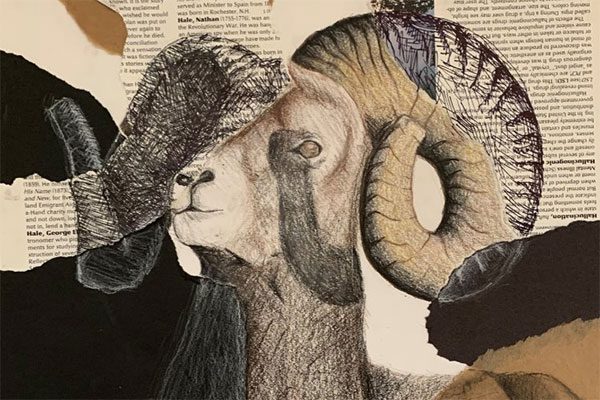
On Thursday, March 10 at noon in the Seattle Presents Gallery, artist Barry Johnson and historian Zola Mumford will discuss the power of data, history and of communities of color owning their stories. The impetus for this conversation is ARTS’ yearlong series in Seattle Presents Gallery, Dialogues in Art: Exhibitions on Racial Injustice, featuring six artists who will use their art to make space for activism and dialogue.
Years ago I saw an interview with Kanye West where he was talking about his history and background as a visual artist. West was accepted into an art school for college but turned it down because he said he couldn’t turn the volume of his paintings up. I was infuriated when I heard this. As a visual artist I interpreted his words to mean that he needed to make music to reach a wide audience rather than stay in the visual realm. But, over the years I have grown to see some truth in this statement. A historical barrier to galleries and museums means the art world is not always accessible.
I think about this statement most when I think of how the art world can be present and engaged in social movements. The keynote at the 2015 Creative Time Summit in New York was Boots Riley, a hip hop artist and activist. He spoke to the attendees about how he wanted his music to inspire revolution and social change. This was the same thing Kanye West was saying. He felt his paintings wouldn’t reach the masses in the same way a mixtape would and that is an idea I want to challenge and change.
Throughout history visual art has catalyzed people to act against injustice, provided inspiration for movements and been at the forefront of protests. I am going to highlight a few of the many artists that inspire me personally in my practice.
Artemisia Gentileschi Judith Slaying Holofernes, c. 1620
 Artemisia Gentileschi, an Italian early Baroque artist, was one of the first artists to speak out against rape culture. She was the first female painter to become a member of the Accademia di Arti del Disegno in Florence and her paintings often have strong, suffering women from myth and the Bible – victims, suicides, warriors. A student of Caravaggio, her paintings had the signature churrascura effect, meaning shading from light to dark, resulting in rich and dramatic paintings. At this time in art history, paintings typically depicted royalty or biblical stories. In Gentileschi’s famous painting Judith Slaying Holofernes she superimposed her own likeness as Judith and her real-life rapist’s face as Holofernes. The painting is dramatic, powerful, and thought provoking. I have always been in awe of the sheer strength it must have taken her in 1612 to out her rapist in a painting.
Artemisia Gentileschi, an Italian early Baroque artist, was one of the first artists to speak out against rape culture. She was the first female painter to become a member of the Accademia di Arti del Disegno in Florence and her paintings often have strong, suffering women from myth and the Bible – victims, suicides, warriors. A student of Caravaggio, her paintings had the signature churrascura effect, meaning shading from light to dark, resulting in rich and dramatic paintings. At this time in art history, paintings typically depicted royalty or biblical stories. In Gentileschi’s famous painting Judith Slaying Holofernes she superimposed her own likeness as Judith and her real-life rapist’s face as Holofernes. The painting is dramatic, powerful, and thought provoking. I have always been in awe of the sheer strength it must have taken her in 1612 to out her rapist in a painting.
Jacques-Louis David The Death of Marat, 1793
 The next artwork that reminds me of the power art has to spark revolution is Jacques-Louis David’s The Death of Marat. David’s works were artistic demands for political action. Jean-Paul Marat, a French revolutionary leader, was a radical journalist and politician. He was assassinated by Charlotte Corday, a Girondist, while in his bath. David’s horrific depiction of Marat slain in the bathtub made him one of the martyrs of the French revolution. The painting was hung in the assembly hall of the National Convention of Deputies. An engraving was made from it and images were widely disseminated. Learning of this in art history I was always moved by the power of visual images in building a movement.
The next artwork that reminds me of the power art has to spark revolution is Jacques-Louis David’s The Death of Marat. David’s works were artistic demands for political action. Jean-Paul Marat, a French revolutionary leader, was a radical journalist and politician. He was assassinated by Charlotte Corday, a Girondist, while in his bath. David’s horrific depiction of Marat slain in the bathtub made him one of the martyrs of the French revolution. The painting was hung in the assembly hall of the National Convention of Deputies. An engraving was made from it and images were widely disseminated. Learning of this in art history I was always moved by the power of visual images in building a movement.
Adrian Piper My Calling (Card), 1986
Lastly I want to talk about My Calling (Card) by artist Adrian Piper. My Calling (Card) was an interactive work that Piper performed unannounced wherever she was from 1986 to 1990. My Calling (Card), consisted of business card size pieces of paper that she handed out to confront people who were making racist comments and assumptions in her presence. The resulting interactions ran the gamut including shame, defensiveness and remorse. This act, while performance art, was also an act of social justice and a reminder that the act of speaking up can be as powerful as a rally.
Please join me on Thursday, March 10 as we continue to move the conversation forward.
Elisheba Johnson, Public Art Program and Seattle Art Commission Liaison at the Office of Arts & Culture.


